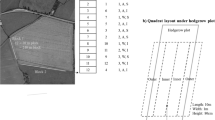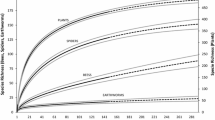Abstract
We studied the tree component of hedgerows resulting from the natural colonization of land plot boundaries’ ditches. These three-meter wide ditches were dug during the European occupation of southeastern Brazil, and are a prominent feature of the landscape. The hedgerows are connected to forest fragments within a farmland matrix. In two systems of hedgerows, we sampled a total of 2.28 ha (114 plots of 200 m²), where we evaluated the structural and floristic similarity between fragments and hedgerows, the similarities between the hedgerows and the fragments’ edges and interior, and the relationships between distribution of tree species and soil variables. The systems presented similar richness and diversity; hedgerows had greater similarity to the fragments included in the same system than to hedgerows of the other system, indicating possible functional linkages between their components (fragments and hedgerows). Tree species composition in the hedgerows was not more similar to the fragment edges as we expected. The hedgerows exhibited greater density and basal area than the fragments. For either single system, species showed preferences for fragments or hedgerows or for sections of the ditch (edge, wall and bottom of the ditch), but for species common in both systems, those preferences were rarely held. The environmental conditions in the ditches seem to favor the establishment of species from the fragments, even those more common in fragment interior, suggesting that, in spite of their narrow widths, these hedgerows may play an important role in the conservation of flora without negatively impacting agriculturally productive rural areas.




Similar content being viewed by others
References
Aguilar R, Quesada M, Ashworth L, Herrerias-Diego Y, Lobo J (2008) Genetic consequences of habitat fragmentation in plant populations: susceptible signals in plant traits and methodological approaches. Mol Ecol 17:5177–5188. doi:10.1111/j.1365-294X.2008.03971.x
Alvares VVH, Novais RF, Dias LE, Oliveira JA (2000) Determinação e uso do fósforo remanescente. Boletim Informativo 25:27–32
APG II––Angiosperm Phylogeny Group (2003) An update of the Angiosperm Phylogeny Group classification for the orders and families of flowering plants: APG II. Bot J Linn Soc 141:399–436
Arroyo-Rodríguez V, Mandujano S (2006) The importance of tropical rain forest fragments to the conservation of plant species diversity in Los Tuxtlas, Mexico. Biodivers Conserv 15:4159–4179. doi:10.1007/s10531-005-3374-8
Baudry JL, Bunce RGH, Burel F (2000) Hedgerows: an international perspective on their origin, function and management. J Environ Manage 60:7–22
Boutin C, Jobin B, Bélanger L, Choinière L (2002) Plant diversity in three types of hedgerows adjacent to cropfields. Biodivers Conserv 11:1–25
Brower JE, Zar JH (1984) Field and laboratory methods for general ecology, 2nd edn. Wm. C. Brown, Dubuque
Burel F, Baudry J (1990) Structural dynamic of a hedgerow network landscape in Brittany France. Landsc Ecol 4:197–210
Camargo JLC, Kapos V (1995) Complex edge effects on soil moisture and microclimate in central Amazonian forest. J Trop Eco 11:205–221. doi:10.1017/S026646740000866X
Causton DR (1988) An introduction to vegetation analysis, principles and interpretation. Unwin Hyman, London
Cerboncini RAS, Passamani M, Braga TV (2011) Use of space by the black-eared opossum in a rural area in southeastern Brazil. Mammalia 75:287–290
Chagas RK, Oliveira Filho AT, van den Berg E, Scolforo JRS (2001) Dinâmica de populações arbóreas em um fragmento de floresta estacional semidecidual montana em Lavras, Minas Gerais. Rev Arvore 25:39–57
Colwell RK (2006) Estimate S: statistical estimation of species richness and shared species from samples. Version 8. <http://purl.oclc.org/estimates>
Corbit M, Marks PL, Gardescu S (1999) Hedgerows as habitat corridors for forest herbs in central New York, USA. J Ecol 87:220–232
de Blois S, Domon G, Boucharda A (2002) Factors affecting plant species distribution in hedgerows of southern Quebec. Biol Conserv 105:355–367
Deckers B, Hermy M, Muys B (2004) Factors affecting plant species composition of hedgerows: relative importance and hierarchy. Acta Oecol 26:23–37
EMBRAPA––Empresa Brasileira de Pesquisa Agropecuária (1997) Manual de métodos de análise de solo, 2nd edn. EMBRAPA, Rio de Janeiro
EMBRAPA––Empresa Brasileira de Pesquisa Agropecuária (2006) Sistema Brasileiro de Classificação dos Solos, 2nd edn. EMBRAPA, Rio de Janeiro
EMBRAPA––Empresa Brasileira de Pesquisa Agropecuária (2009) Manual de análises químicas de solos, plantas e fertilizants, 2nd edn. EMBRAPA, Brasília
FAO-UNESCO (1988) Soil map of the World. Revised legend with corrections. World resources report 60
Forman RTT (1995) Land mosaics: the ecology of landscapes and regions. Cambridge University Press, Cambridge
Fritz R, Merriam G (1994) Fencerow and forest edge vegetation structure in eastern Ontario farmland. Ecoscience 1:160–172
Gabriel VA, Pizo MA (2005) O uso de cercas-vivas por aves em uma paisagem fragmentada de Mata Atlântica. Nat Conserv 3:79–89
Gilbert-Norton L, Wilson R, Stevens JR, Beard KH (2010) A meta-analytic review of corridor effectiveness. Conserv Biol 24:660–668
Gotelli NJ, Colwell RK (2011) Estimating species richness. In: Magurran AE, McGill BJ (eds) Biological diversity: frontiers in measurement and assessment. Oxford University Press, Oxford, pp 39–54
Hansen M, Clevenger AP (2005) The influence of disturbances and habitat on the frequency of non-native plant species along transportation corridors. Biol Conserv 125:249–259
Harvey CA, Villanueva C, Villacís J et al (2005) Contribution of live fences to the ecological integrity of agricultural landscapes. Agric Ecosyst Environ 111:200–230. doi:10.1016/j.agee.2005.06.011
Hill MO, Gauch HG (1980) Detrended correspondence analysis: an improved ordination technique. Vegetatio 42:47–58
Hubbell SP (2001) The unified neutral theory of biodiversity and biogeography. Princeton University Press, Princeton
Hubbell SP (2005) Neutral theory in community ecology and the hypothesis of functional equivalence. Funct Ecol 19:166–172
Hughes JB, Daily GC, Ehrlich PR (2002) Conservation of tropical forest birds in countryside habitats. Ecol Lett 5:121–129
Instituto Brasileiro de Geografia Estatística (IBGE) (2004) Mapa de vegetação do Brasil. IBGE, Rio de Janeiro
Lemos RC, Santos RD (1984) Manual de descrição e coleta de solo no campo, 2nd edn. Sociedade Brasileira de Ciência do Solo, Campinas
León M, Harvey C (2006) Live fences and landscape connectivity in a neotropical agricultural landscape. Agrofor Syst 68:15–26. doi:10.1007/s10457-005-5831-5
Levey DJ, Bolker BM, Tewksbury JJ, Sargent S, Haddad NM (2005) Effects of landscape corridors on seed dispersal by birds. Science 309:146–148. doi:10.1126/science.1111479
Magnussen S, Boyle TJB (1995) Estimating sample size for inference about the Shannon-Weaver and the Simpson indices of species diversity. Forest Ecol Manag 78:71–84. doi:10.1016/0378-1127(95)03596-1
Martins FR (1991) Estrutura de uma floresta mesófila. UNICAMP, Campinas
McCollin D, Jackson JI, Bunce RGH, Barr CJ, Stuart R (2000) Hedgerows as habitat for woodland plants. J Environ Manage 60:77–90
McCune B, Grace JB (2002) Analysis of ecological communities. MjM Software Design, Gleneden Beach
McCune B, Mefford MJ (2006) PC-ORD: multivariate analysis of ecological data. Version 5.10. MjM Software, Gleneden Beach
Mesquita AO, Passamani M (2012) Composition and abundance of small mammal communities in forest fragments and vegetation corridors in Southern Minas Gerais, Brazil. Int J Trop Biol 60:1335–1343
Metzger JP, Décamps H (1997) The structural connectivity threshold: an hypothesis in conservation biology at the landscape scale. Acta Oecol 18:1–12
Mori SA, Silva LAM, Lisboa G, Coraden L (1989) Manual de herbário fanerogâmico, 2nd edn. CEPEC, Ilhéus
Mueller-Dombois D, Ellenberg H (1974) Aims and methods of vegetation ecology. Wiley, New York
Murcia C (1995) Edge effects in fragment forests: implications for conservation. Trends Ecol Evol 10:58–62
Oliveira Filho AT, Mello JM, Scolforo JRS (1997) Effects of past disturbance and edges on tree community structure and dynamics within a fragment of tropical semideciduous forest in south-eastern Brazil over a five year period (1987–1992). Plant Ecol 131:45–66
Otero J, Onaindia M (2009) Landscape structure and live fences in Andes Colombian agrosystems: upper basin of the Cane-Iguaque River. Revista de Biología Tropical 57:1183–1192
Pardini R, Souza SM, Braga Neto R, Metzger JP (2005) The role of forest structure, fragment size and corridors in maintaining small mammal abundance and diversity in an Atlantic forest landscape. Biol Conserv 124:253–266
Pascal C, Philip R, Thierry T (2006) Factors explaining shrub species distribution in hedgerows of a mountain landscape. Agr Ecosyst Environ 116:244–250
Pinto SRR, Mendes G, Santos AMM, Dantas M, Tabarelli M, Melo FPL (2010) Landscape attributes drive complex spatial microclimate configuration of Brazilian Atlantic forest fragments. Trop Conserv Science 3:389–402
Pulido-Santacruz P, Miguel Renjifo L (2011) Live fences as tools for biodiversity conservation: a study case with birds and plants. Agrofor Syst 81:15–30. doi:10.1007/s10457-010-9331-x
Ribeiro MC, Metzger JP, Martensen AC, Ponzoni FJ, Hirota MM (2009) The Brazilian Atlantic forest: how much is left, and how is the remaining forest distributed? Implications for conservation. Biol Conserv 142:1141–1153
Rocha MF, Passamani M, Louzada J (2011) A Small Mammal Community in a forest fragment, vegetation corridor and coffee matrix system in the Brazilian Atlantic forest. PLoS One 6:e23312. doi:10.1371/journal.pone.0023312
Roy V, de Blois S (2006) Using functional traits to assess the role of hedgerow corridors as environmental filters for forest herbs. Biol Conserv 130:592–603
Smart SM, Bunce RGH, Stuart RC (2001) An assessment of the potential of British hedges to act as corridors and refuges for ancient woodland indicator plants. In: Barr C, Petit S (eds) Hedgerows of the world: their ecological functions in different landscapes. University of Birmingham, Birmingham, pp 137–146
Sokal RR, Rohlf FJ (1995) Biometry: the principles and practice of statistics in biological research. W. H. Freeman, New York
Sørensen T (1948) A new method of establishing groups of equal amplitude in plant sociology based on similarity of species content and its application to analyses of the vegetation on Danish commons. Biol Skrif 5:1–34
Souza AF, Cortez LSR, Longhi SJ (2012) Native forest management in subtropical South America: long-term effects of logging and multiple-use on forest structure and diversity. Biodivers Conserv 21:1953–1969. doi:10.1007/s10531-012-0287-1
Tewksbury JJ, Levey DJ, Haddad NM et al (2002) Corridors affect plants, animals, and their interactions in fragmented landscapes. PNAS 99:12923–12926. doi:10.1073/pnas.202242699
Uezu A, Metzger JP, Vielliard JME (2005) Effects of structural and functional connectivity and patch size on the abundance of seven Atlantic Forest bird species. Biol Conserv 123:507–519
van Geert A, van Rossum F, Triest L (2010) Do linear landscape elements in farmland act as biological corridors for pollen dispersal? J Ecol 98:178–187. doi:10.1111/j.1365-2745.2009.01600.x
Veloso HP, Rangel Filho ALR, Lima JCA (1991) Classificação da vegetação brasileira adaptada a um sistema universal. IBGE, Rio de Janeiro
Vettori L (1969) Métodos de análises de solos. Ministério da Agricultura, Rio de Janeiro
Wehling S, Diekmann M (2009) Importance of hedgerows as habitat corridors for forest plants in agricultural landscapes. Biol Conserv 142:2522–2530
Zar JH (1996) Biostatistical analysis, 3rd edn. Prentice-Hall, Upper Saddle River
Acknowledgments
We thank the Coordenação de Aperfeiçoamento de Pessoal de Nível Superior (CAPES), Conselho Nacional de Desenvolvimento Científico e Tecnológico (CNPq) and Fundação de Amparo à Pesquisa do Estado de Minas Gerais (FAPEMIG) for the financial support. We also thank Antônio Rufino, Marcela Castro, Grazielle Sales, Evandro Machado, Sérgio G. Martins, Matheus Nunes, Renata Vilagres, Richieri Sartori and Marília Gabriela for the aid in the field. We thank the land owners in the Serrinha region and NKG Fazendas Brasileiras S.A. for their logistical support and permission for this study. We thank Ary Teixeira de Oliveira Filho and Marcos Sobral for their help with species identification and João José Granate de Sá and Mello Marques for soil classification.
Author information
Authors and Affiliations
Corresponding author
Rights and permissions
About this article
Cite this article
de Castro, G.C., van den Berg, E. Structure and conservation value of high-diversity hedgerows in southeastern Brazil. Biodivers Conserv 22, 2041–2056 (2013). https://doi.org/10.1007/s10531-013-0524-2
Received:
Accepted:
Published:
Issue Date:
DOI: https://doi.org/10.1007/s10531-013-0524-2




